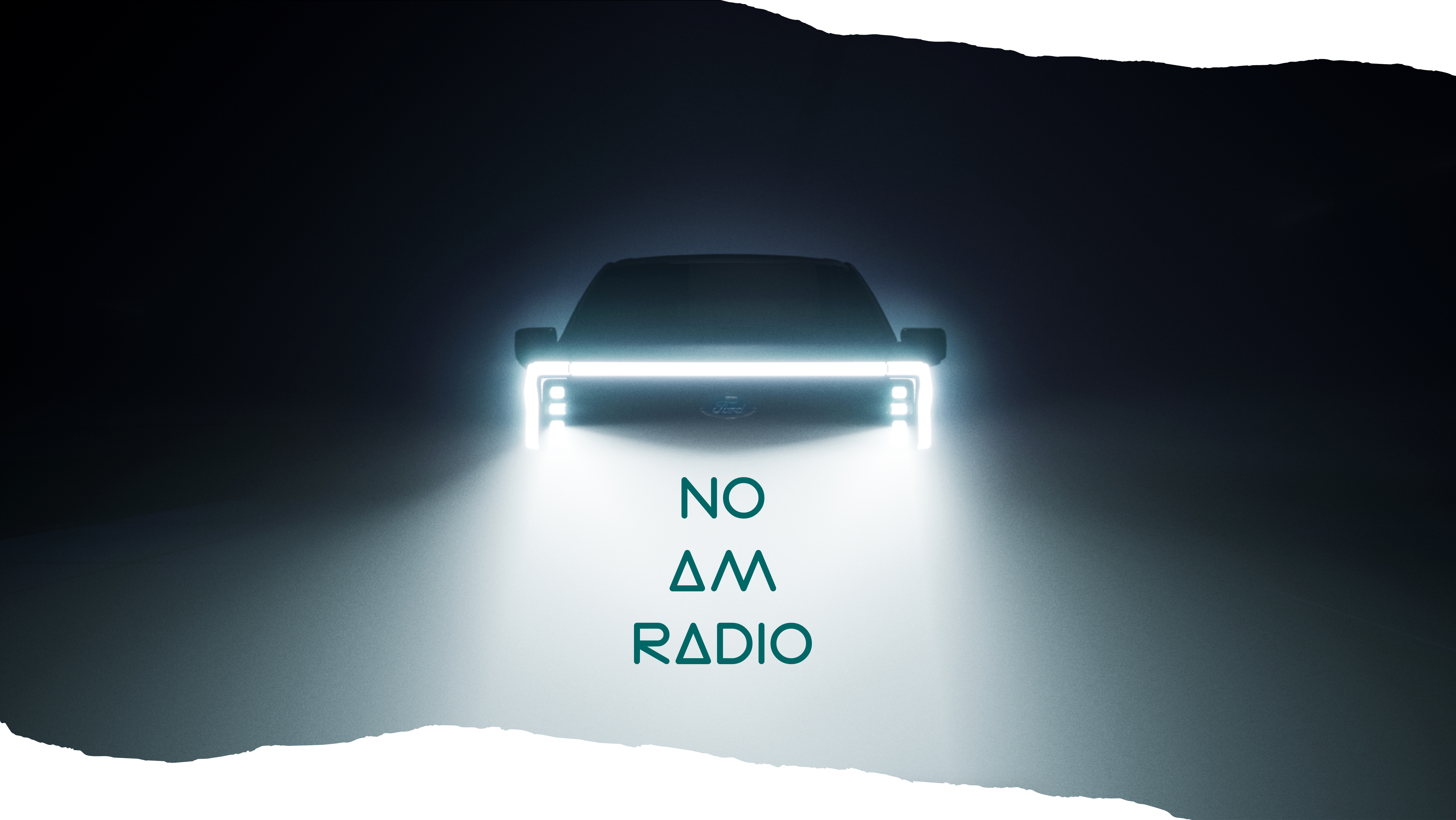
Photo: Ford Media
These days, the auto industry is as disrupted as broadcast radio. Like the radio companies – a group of independent operators, each moving down a different pathway – automakers are highly individual companies.
And in much the same way radio broadcasters have been rocked by digital players – streamers, podcasters, satellite radio – the auto companies have watched an outsider by the name of Elon Musk transform the way cars (and soon trucks) are designed, built, and sold. Love him or loathe him, Musk’s initial commitment to electric vehicles has transformed the industry. (And we’ll be staying tuned to Twitter to see how Musk goes about transforming a grossly underperforming social platform.)
Ford CEO Jim Farley got the memo. And his company has jumped on the EV bandwagon in a big way. The Mustang Mach E electric SUV has been a big hit, paving the way to the biggest risk of them all, the F-150 EV called “Lightning.”
The company has led the way in trucks for decades with the F-150, the most successful in its class. But manufacturing the electric version of this truck represents a major risk for the company – and perhaps a turning point of the internal combustion engine. The new 2023 model of the F-150 is slick, with some hot new features – including a new backup camera when the tailgate is down, software updates, and other tech innovations.
But there’s something missing from the newest F-150 Lightning truck:
AM RADIO
That’s right. Following in the footsteps of Musk’s Teslas, this amazing truck won’t be able to receive stations like WABC, WWL, WGN, and other AM stalwarts, still slugging it out in the broadcast radio landscape. These stations will be accessible via apps, of course, but the AM tuner is a thing of the past in these forward-leaning F-150 Lightnings.
I’ve written about the interference issues facing AM radio in EVs. The 2022 F-150 Lightning had a whip antenna to facilitate AM reception. Now, the Ford brain trust has apparently concluded it’s not worth the expense for a radio platform that is clearly facing the death spiral. True, FM translators and HD Radio have helped AM stations sustain themselves. But if occupants of F-150 Lightnings in Iowa want to tune in WHO for its farm show, they’ll have to use the iHeartRadio app or another digital service.
Even core radio fans are no longer sold on AM radio. In this year’s Techsurvey, we ask new car buyers (9% of the total sample) about the most important features they want in their next vehicle. The headline tells an important story. For the first time, Bluetooth is a stronger must-have feature, edging out FM radio. That’s disturbing, of course. But look down the list, and you come to AM radio. And only one-third of these new car customers list it as a “most important” feature.
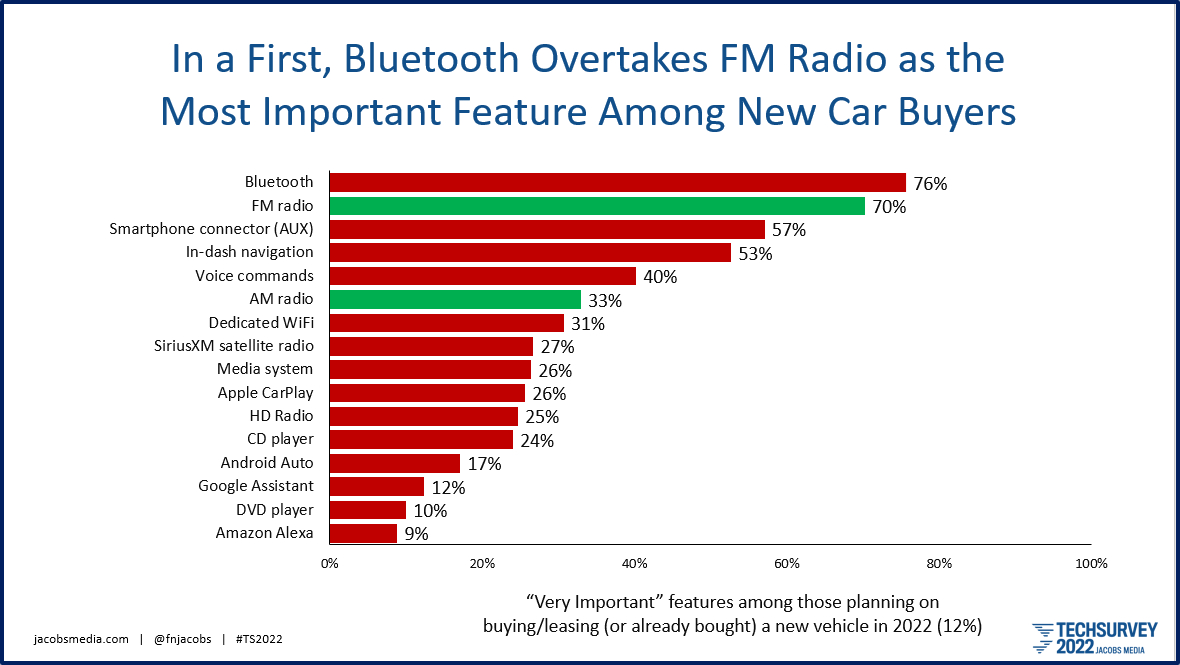
Ostensibly, Ford and the other automakers know this, too. And when consumer demand ebbs on a feature – even one with a long tradition like AM radio – the OEMs aren’t going to continue pouring money into it out of the kindness of their corporate hearts or even a sense of social responsibility. And why should they.
 You’d think the radio broadcasting industry would be up in arms about this seminal decision from Ford, but I’ve heard very little reaction. And unlike Tesla, when one of the American “Big 3” like Ford makes this kind of decision, you might expect other automakers will follow suit for their EV models. Interestingly, former acting FEMA head, Pete Gaynor (pictured), called out Ford for putting “public safety at risk.”
You’d think the radio broadcasting industry would be up in arms about this seminal decision from Ford, but I’ve heard very little reaction. And unlike Tesla, when one of the American “Big 3” like Ford makes this kind of decision, you might expect other automakers will follow suit for their EV models. Interestingly, former acting FEMA head, Pete Gaynor (pictured), called out Ford for putting “public safety at risk.”
In an Inside Radio story, another FEMA administrator, Craig Fugate, noted that when he was in Florida during Hurricane Irma in 2017, all power was out in his community. “The only way I could get any updates on what was happening was off the radio,” he noted. Wonder if Fugate will be buying a new F-150 anytime soon.
The Detroit News published a commentary from Gaynor this past Sunday. He wrote:
“We are indeed living in an era where we are slowly losing luxuries we once mistook as basic standards. But the reality is that the AM radio is not a luxury but a necessity — one of great national security importance. The country cannot afford to lose AM radio from their cars — not today, not tomorrow, not ever. When making this decision, Ford was likely unaware of the move’s implications.”
I think Ford was plenty aware of what it was doing – saving money on each and every truck that rolls off its assembly line. Automakers have been graciously installing AM/FM radios in their dashboards for most of a century – with absolutely no revenue from broadcasters who have monetized its presence in millions of cars and trucks for as long as anyone can remember.
Not anymore.
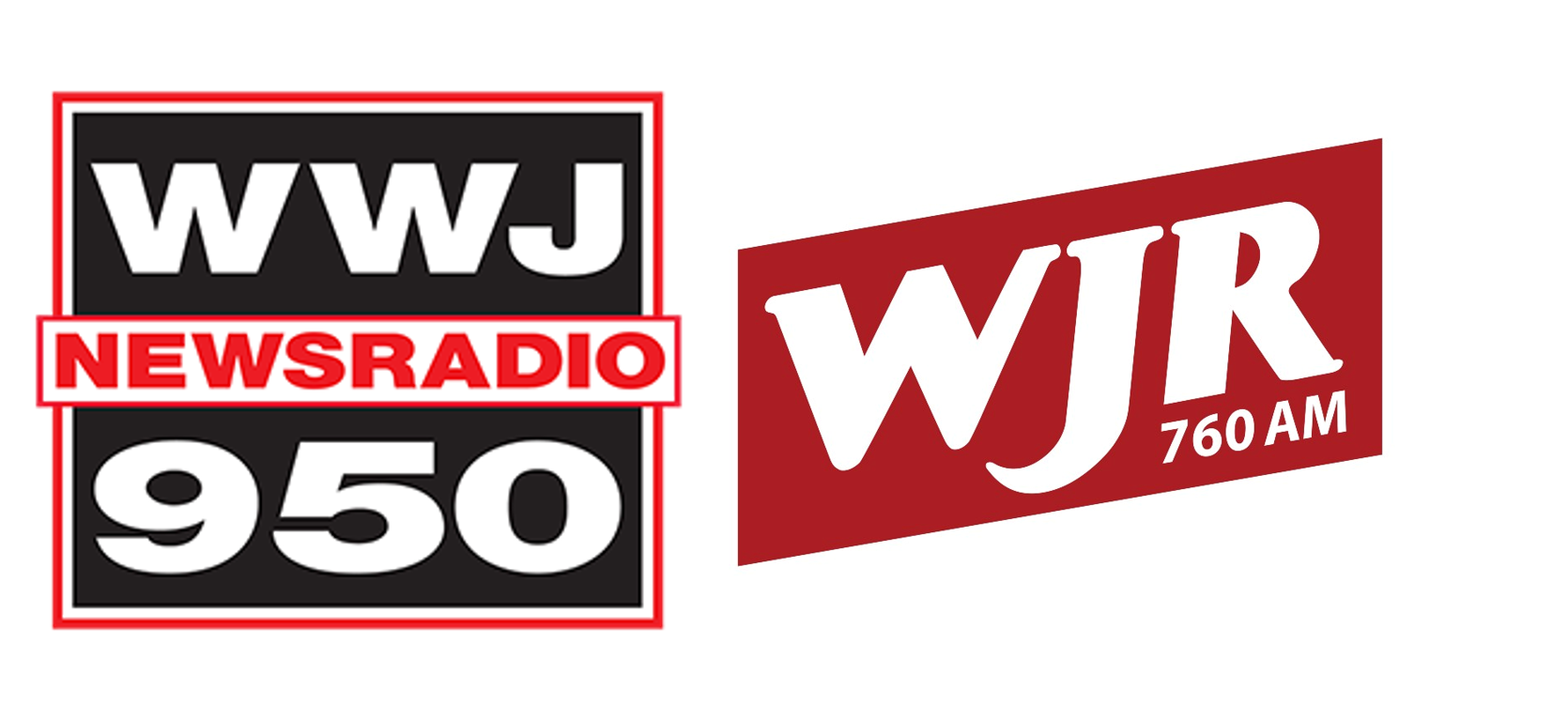 Here in Detroit, still the auto capitol of the world, we have viable AM radio stations that can’t be too happy about Ford’s momentous decision. WJR (Cumulus) and WWJ (Audacy) are still factors in the radio marketplace, still generating impressive revenue marks in spite of aging audiences. In this market, many auto execs listen to these stations, and Tier 1 manufacturers often advertise on both, eager to reach a very small cume of automotive decision-makers.
Here in Detroit, still the auto capitol of the world, we have viable AM radio stations that can’t be too happy about Ford’s momentous decision. WJR (Cumulus) and WWJ (Audacy) are still factors in the radio marketplace, still generating impressive revenue marks in spite of aging audiences. In this market, many auto execs listen to these stations, and Tier 1 manufacturers often advertise on both, eager to reach a very small cume of automotive decision-makers.
Still, the industry trend is obvious. As Audacy recently did in New York City, broadcasters are blowing up their weakest FM station to make room for strong AM brands like 1010 WINS. Logic tells us this will continue. And the auto companies are taking note.
In an obvious slap in the face to radio broadcasters, Ford is sending the message that AM radio doesn’t really matter to their drivers. And if you’re wondering about all those farmers listening to ag reports on nearby AM stations, it turns out they may be as tech-savvy as urban dwellers and suburbanites.
In Techsurvey, we measure how our core radio listeners tune in their favorite radio stations. “Traditional” listening takes place on “real radios” – on the nightstand, in the car, on the workbench. “Digital,” of course, represents streaming on mobile apps and tablets, computers, and on smart speakers. A look at our total sample versus those who live in rural areas reveals no significant difference in the way each listens to broadcast radio.
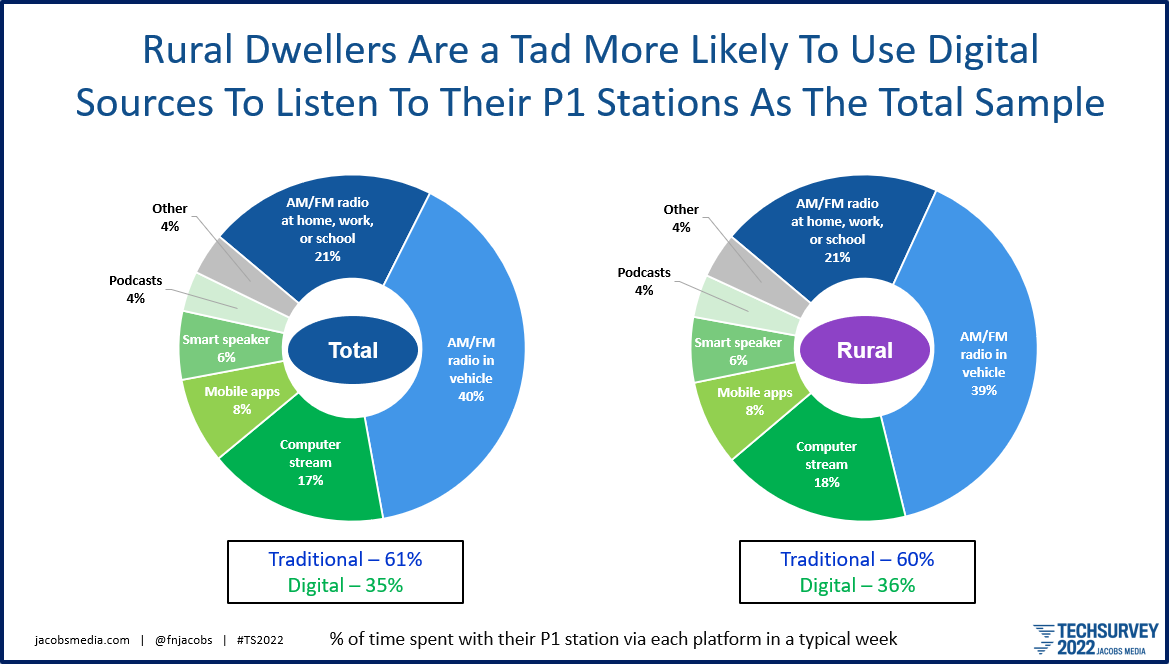
This was confirmed for me qualitatively last year when we did focus groups among farmers in the upper Midwest. The takeaway? These folks are pretty tech-savvy. Their John Deere tractors and other vehicles are well-equipped with Bluetooth, GPS, and other technology. Some have Apple CarPlay. In other words, even if they end up buying F-150 Lightnings for their farm-related work, they’ll find a way to listen to their favorite stations.
(Ironic, isn’t it, that streaming – roundly criticized by many broadcasters over the years – could likely end up being the salvation for AM stations slow to come around to its accessibility?)
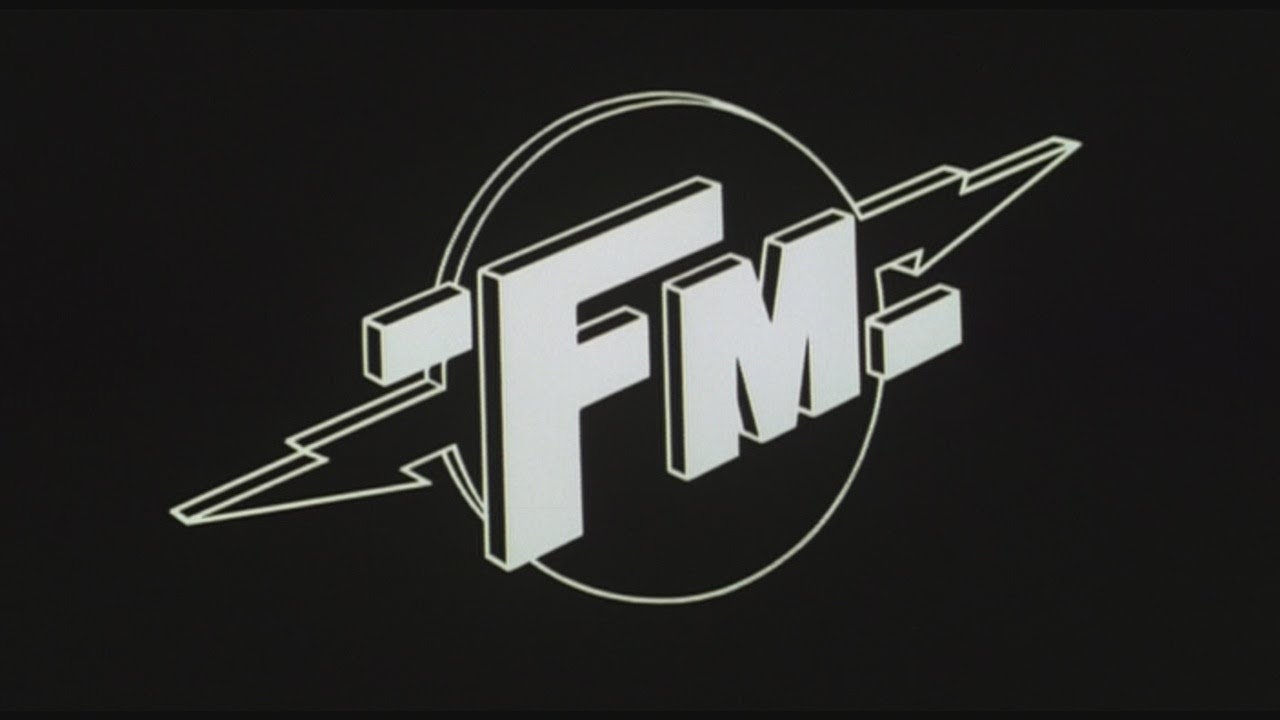 Stepping back from the Ford decision and the reverberations it may create, it seems like this is more of a statement about how automakers perceive the continued viability of RADIO. If FM operators are the least bit smug over the absence of AM on F-150 touchscreens, they should think twice about the implications of this move.
Stepping back from the Ford decision and the reverberations it may create, it seems like this is more of a statement about how automakers perceive the continued viability of RADIO. If FM operators are the least bit smug over the absence of AM on F-150 touchscreens, they should think twice about the implications of this move.
For too long, radio broadcasters have been hesitant to improve the way they look on today’s high tech dashboards, despite the best efforts of the NAB and metadata display companies like Quu Interactive. In most markets, a simple scan of the FM dial from 88 to 108 reveals checkerboard results. Some stations look good and even great, while others are behind the curve, or worse, worried more about displaying the ambulance-chasing lawyers in town than the artists and titles of the songs they play.
 I was pleased to read a new commentary by auto guru, Roger Lanctot, who recently got a huge software update on his late model Hyundai. When the bits and bytes were downloaded, Roger was looking at Xperi’s slick AutoStage platform on his screen.
I was pleased to read a new commentary by auto guru, Roger Lanctot, who recently got a huge software update on his late model Hyundai. When the bits and bytes were downloaded, Roger was looking at Xperi’s slick AutoStage platform on his screen.
Here’s how the “most connected guy in the connected car industry” thought about this dashboard transformation:
“This Hyundai software update will change the way Hyundai owners – and others – think about software updates. It simultaneously enhances the value of the embedded navigation and the long overlooked radio – both unique auto-centric applications. It also shows Hyundai significantly closing the user experience gap with Tesla.”
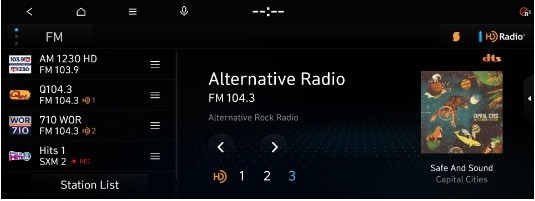
So, with Ford, a big step back. But with Hyundai and Xperi, a giant leap forward.
There’s work to be done here, fellow broadcasters. You just never know when lightning may strike.
P.S. Jacobs Media has added a second CES Tour for Radio Broadcasters in January. This is your opportunity to see the latest and greatest in technology and innovation, including a deep dive in the automotive space. You’ll even have your chance to ask a Ford executive, “WTF?” Info on our tours is here.
- Why Radio P.D.s Are A Lot Like NBA Coaches - May 8, 2025
- Memo To Radio: We Have Met The Enemy And It Is… - May 7, 2025
- The Guy In The Next Car - May 6, 2025




The Lanctot blog doesn’t really describe how the software update is helpful, but yeah it could be a plus for radio…but it also mentions other audio options. It’s a given that “radio” (as we know it) won’t get the prime position on the dash that it’s had for as long as people got audio entertainment in vehicles. Too many other options that have desirable attributes. But- there is still hope for broadcasters if they can develop “now” info for listeners. As you stated, Fred-the lack of AM radio in some vehicles kind of isolates the driver from important news information. Stations like KDKA, WABC, KNX, WLW and now WINS are making the move to FM -whether it be with flea-powered translators or full- signal FM sticks, it could be just a band-aid as the transition from OTA to digital ramps up. But as one of Roger’s commenters states, we’re not plug and play yet. You can bet there will be millions of consumers who won’t go through the painstaking process of updating their entertainment system software. But on the radio side, AM has been on life support for decades. Rush Limbaugh helped a little, but his replacements aren’t quite making the impact he had. The AM band is fraught with conservative talkers, ethnic and paid programming (secular and religious) and electronic hash that’s making a 5,000 watt station in Upstate New York (where Ted Baxter got his start) virtually worthless. The FCC is useless in trying to enforce its rules regarding electronic interference and receiver manufacturers who could (if they would put the R and D into making better AM radios) just won’t do it. We know the technology exists to make the audio experience on the road (and in the home) a zillion percent better-whether it be AM, FM, Short Wave or streaming, but if the consumer doesn’t want that, it’s not gonna happen. It’s up to broadcasters to make the listening public aware that what they want is available to them. If it’s free, it will be even better. This is a very poignant post, Fred- and it points out once again where the big broadcasters are failing the public – and now the auto industry is following. At least that’s my opinion from what I see. I don’t think I’m alone.
You make great points, Dave. There’s always the chicken/egg of it. If AM was more vital, diverse, and compelling, it wouldn’t be so easy for Ford or other OEMs to pull the plug. And as I pointed out, FM is just a few yards up the beach. It DOES come down to consumer demand, and the auto companies are undoubtedly doing research of their own. If AM radio tests poorly as a “must have” in new cars in Techsurvey, what does that tell us? Thanks for a great first comment. There will be more.
Spot on, Dave, in citing FCC for its dereliction enforcing the rules that would prevent the interference. I could be snide and suggest Ford’s deletion of AM is doing for the air inside the vehicle what its propulsion system is doing for air outside the vehicle; but better to say the radio industry should get serious about improving signal quality, and drag FCC along somehow. The radio industry hasn’t seriously tried to improve AM since the ’80s. Maybe better quality would attract more programming diversity back to the band. I can hope.
Among several AMAX receivers, I still have my Denon TU-680NAB, one of the best tuners ever made. But it’s been set to the FM band for years because there’s just nothing happening on the AM band.
Dave, as always, I appreciate the thoughtful response to a blog post that has generated a lot of conversation. There’s a lot to unpack here – AM technical problems and new tech options. But I’m wondering if the biggest factor isn’t the limited and deteriorating content on what’s left of the AM band. Sadly, a station like WWJ or WJR are nice stores located in a mall that’s in a bad part of town Eventually, people stop going.
Fred, I can’t believe that I am the first to respond to your excellent expose of what is happening the AM radio band. Like you, those of us of a certain age, grew up on AM radio and were “thrilled & excited” when we got that first of many transistor radios. Many people are aware of what an intense radio geek I am. However, when I was just up north in Michigan wanting to hear WJR’s Paul W. Smith, I couldn’t handle the static over the air as close as mid-state or even Lansing! So, I brought it up on my cell phone via my radio app and boom…it was clearer than at my home in suburban Detroit. I do the same Saturday mornings with 700 WLW from Cincinnati. It’s great. Now, with the premier all-news station in New York, 1010 WINS flipping to 92.3 FM, what is this saying? They remain on AM, but now it’s available in more places. Can we be far behind with our WJR and/or WWJ? My car is so old, it has no Bluetooth or auxiliary jack. I’m forced into using a cassette adapter. I have a 2005 model with both a cassette and CD player… wow! It is called progress, and even I, who still loves all that AM radio has to offer, have come to the realization that, yup technology is forcing us to change our long-standing listening habits and, in the long run, it WILL be better.
These aare good points, Art. The reception on AM has gotten progressively worse. But streaming technology and HD2s can change the game for AM broadcasters. I’m not sure how cassette decks figure into the whole thing, however. Thanks for commenting.
Ha! Glad to know I’m not the only one with an old car (older than yours–a 2001!) complete with AM/FM/CD/Cassette, Art! I actually have a cassette adapter from XM Satellite radio to stream my phone in the car! Pretty low tech (and oh, how it impresses the ladies to have a wire coming out of the tape deck of your 20+ year-old-car) but it sounds amazing! Great memories, for sure, especially of those old transistor radios that first got us addicted to radio, but in the end, as you said, things WILL get better!
Excellent Broadcast Content is Essential. The popularization of AM HD and AM on the digital stream is magnificent and heard far beyond the normal on-air coverage. My Toyota JBL sounds superb with 1220watx.com – a new dimension in local service with Connecticut Gold and real personality, growing every day. A broadcast license is a terrible thing to waste. All channel reception was introduced for good reason.
Appreciate hearing from you, Clark.
FCC Part 15 regs state that a device generating interference in the broadcast bands is considered illegal.
Guess that rule went the way of CB licenses.
A few years ago,I bought a couple of Sangean portable radios that feature FM and internet radio reception.The set had a USB jack for USB drives and an AUX input for other consumer devices.Both radios work well,but one day I wondered why these sets didn’t have AM broadcast reception.
I heard from other sources that the internal electronics produce so more hash,it was not worth it to include AM broadcast.Nowadays when I travel and use these sets,they work very well on the run.
I do have an portable C. Crane portable radio with AM reception accompanying me sometimes,but when I tune to that band,I get all sorts of hash and buzzing sounds. With that type of interference,no wonder the public is getting turned off on AM broadcast.
You’re well beyond my understanding of AM signal propagation. I just know it sounds lousier and has much worse reception than it used to have. The listener experience is awful.